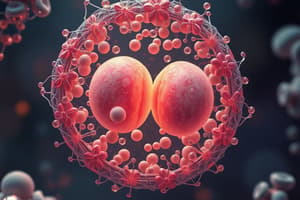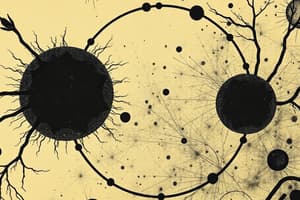Podcast
Questions and Answers
What occurs during the S phase of interphase?
What occurs during the S phase of interphase?
- DNA replication occurs. (correct)
- The cell grows and synthesizes proteins.
- Nuclear envelopes reform around separated chromosomes.
- Chromosomes condense and spindle fibers form.
Which phase is characterized by cells not actively preparing to divide?
Which phase is characterized by cells not actively preparing to divide?
- G0 Phase (correct)
- S Phase
- G2 Phase
- G1 Phase
What is the primary function of tumor suppressor genes?
What is the primary function of tumor suppressor genes?
- To repair DNA damage
- To promote cell division
- To cause mutations in oncogenes
- To inhibit cell division (correct)
During which mitotic phase do sister chromatids separate and move to opposite poles?
During which mitotic phase do sister chromatids separate and move to opposite poles?
How do cytokinesis processes differ between plant and animal cells?
How do cytokinesis processes differ between plant and animal cells?
What is the role of the G1 checkpoint in the cell cycle?
What is the role of the G1 checkpoint in the cell cycle?
Which of the following describes proto-oncogenes?
Which of the following describes proto-oncogenes?
What best defines the G0 phase in the cell cycle?
What best defines the G0 phase in the cell cycle?
What is the primary purpose of cell division in unicellular organisms?
What is the primary purpose of cell division in unicellular organisms?
Which statement accurately describes daughter cells produced by mitosis?
Which statement accurately describes daughter cells produced by mitosis?
How do eukaryotic genomes differ from prokaryotic genomes?
How do eukaryotic genomes differ from prokaryotic genomes?
What characterizes homologous chromosomes?
What characterizes homologous chromosomes?
What role do centrosomes play in animal cells?
What role do centrosomes play in animal cells?
What is the difference between somatic cells and gametes?
What is the difference between somatic cells and gametes?
What is the function of the spindle apparatus during mitosis?
What is the function of the spindle apparatus during mitosis?
Which statement is true regarding chromosome numbers across different species?
Which statement is true regarding chromosome numbers across different species?
What is the primary purpose of helicase during DNA replication?
What is the primary purpose of helicase during DNA replication?
Which of the following accurately describes the lagging strand during DNA replication?
Which of the following accurately describes the lagging strand during DNA replication?
What mechanism is primarily responsible for maintaining genome stability during DNA replication?
What mechanism is primarily responsible for maintaining genome stability during DNA replication?
Which enzyme synthesizes short RNA primers necessary for DNA polymerases to initiate synthesis?
Which enzyme synthesizes short RNA primers necessary for DNA polymerases to initiate synthesis?
What is the function of single-stranded binding proteins (SSB) during DNA replication?
What is the function of single-stranded binding proteins (SSB) during DNA replication?
What role does DNA Polymerase I play in DNA replication?
What role does DNA Polymerase I play in DNA replication?
What structure is formed at the replication fork during DNA replication?
What structure is formed at the replication fork during DNA replication?
What is the effect of topoisomerase during DNA replication?
What is the effect of topoisomerase during DNA replication?
Flashcards are hidden until you start studying
Study Notes
Reproduction at the Cellular Level
- Unicellular organisms reproduce by dividing to create two identical offspring.
- Multicellular organisms use cell division for growth, development, and repair, allowing them to replace damaged cells and grow larger.
- Mitosis creates genetically identical daughter cells, ensuring the same number of chromosomes and DNA sequences.
- Prokaryotic genomes are circular DNA molecules without a nucleus, whereas eukaryotic genomes are linear DNA molecules within a nucleus.
- A replicated chromosome consists of two sister chromatids joined at the centromere, while an unreplicated chromosome is a single linear DNA molecule with associated proteins.
- Chromosome number varies between species, with humans having 46 and fruit flies having 8. All members of a species generally have the same chromosome number. Somatic cells have a full set (diploid), while gametes have half (haploid).
- Centrosomes, located in animal cells, are the primary microtubule organizing centers and contain a pair of centrioles, cylindrical structures that help form the spindle apparatus.
- The spindle apparatus is a microtubule structure that segregates chromosomes during mitosis.
- Somatic cells are body cells with a full set of chromosomes (diploid), while gametes, the reproductive cells, have half the number of chromosomes (haploid).
- Homologous chromosomes are pairs with the same genes but different alleles. Heterologous chromosomes don't pair during meiosis and have distinct structures and gene content.
The Cell Cycle
- The cell cycle encompasses interphase (G1, S, G2 phases) and the mitotic phase (mitosis and cytokinesis).
- G0 phase, a non-replicative phase, involves cells not actively preparing to divide.
- Interphase consists of:
- G1 phase: Cell growth and protein synthesis.
- S phase: DNA replication occurs.
- G2 phase: Continued growth and preparation for mitosis.
- G0 phase can be:
- Quiescent: Temporarily not dividing.
- Senescent: Permanently not dividing due to aging or damage.
- Differentiated: Specialized cells that do not divide.
- Mitosis is comprised of the following phases:
- Prophase: Chromosomes condense, and spindle fibers develop.
- Prometaphase: The nuclear envelope disintegrates, and spindle fibers attach to kinetochores.
- Metaphase: Chromosomes align at the metaphase plate.
- Anaphase: Sister chromatids separate and migrate to opposite poles.
- Telophase: Nuclear envelopes reform around the separated chromosomes.
- Cytokinesis, the division of cytoplasm, forms two separate daughter cells.
- Cytokinesis differs in plants and animals:
- Plants: A cell plate forms.
- Animals: A cleavage furrow forms.
- Cell cycle checkpoints exist to ensure proper cell division:
- G1 checkpoint: Checks for adequate cell size, nutrients, growth factors, and DNA damage.
- G2 checkpoint: Checks for DNA damage and complete DNA replication.
- Mitotic checkpoint: Ensures all chromosomes are attached to the spindle apparatus before entering anaphase.
- The G1 checkpoint marks commitment to cell division.
Cancer and the Cell Cycle
- Cancer is uncontrolled cell division caused by mutations in genes that regulate the cell cycle.
- Cells become cancerous through mutations that lead to uncontrolled growth and division.
- Proto-oncogenes, normal genes that promote cell growth, become oncogenes when mutated, contributing to cancer development.
- Tumor suppressor genes normally inhibit cell division, and their mutations can lead to cancer.
Prokaryotic Cell Division
- Prokaryotic cells divide through binary fission, where the cell replicates its DNA and splits into two identical daughter cells.
DNA Replication Process
- DNA replication is the process of copying a DNA molecule.
- Replication begins at specific sites called origins of replication, where the DNA unwinds.
- The process involves three main stages: initiation, elongation, and termination.
- During elongation, new DNA strands are synthesized using existing strands as templates.
- Termination marks the completion of DNA synthesis and the resolution of replication structures.
Leading And Lagging Strands
- The leading strand is synthesized continuously in the direction of the replication fork.
- It follows the helicase enzyme as the DNA unwinds.
- The lagging strand is synthesized discontinuously in short segments called Okazaki fragments.
- The lagging strand elongates away from the replication fork.
Fork Geometry And Dynamics
- The replication fork is a Y-shaped structure where the DNA double helix is separated.
- The fork moves dynamically as the DNA is unwound and new strands are synthesized.
- Proteins bind to the DNA at the fork to maintain its stability and ensure proper progression.
Genome Stability During Replication
- DNA polymerases have proofreading capabilities to correct mismatches during replication, ensuring accuracy.
- Mechanisms exist to identify and repair damaged DNA during replication, further contributing to genome stability.
- Specialized proteins and enzymes help prevent fork collapse and ensure accurate duplication of the genome.
Replication Enzymes
- Helicase unwinds the DNA double helix at the replication fork, separating the strands for replication.
- DNA polymerase I removes RNA primers and fills in gaps during replication, also contributing to accuracy.
- DNA polymerase III is the primary enzyme responsible for synthesizing new DNA strands during replication.
- Primase synthesizes short RNA primers, providing a starting point for DNA polymerases to begin replication.
- The RNA primer is removed after DNA synthesis to maintain the integrity of the final DNA strands.
- Single Stranded Binding Protein stabilizes the exposed single strands of DNA during replication.
- Topoisomerase relieves torsional stress ahead of the replication fork, preventing supercoiling.
- DNA ligase joins Okazaki fragments on the lagging strand, sealing nicks in the DNA backbone to produce a continuous strand.
Studying That Suits You
Use AI to generate personalized quizzes and flashcards to suit your learning preferences.




